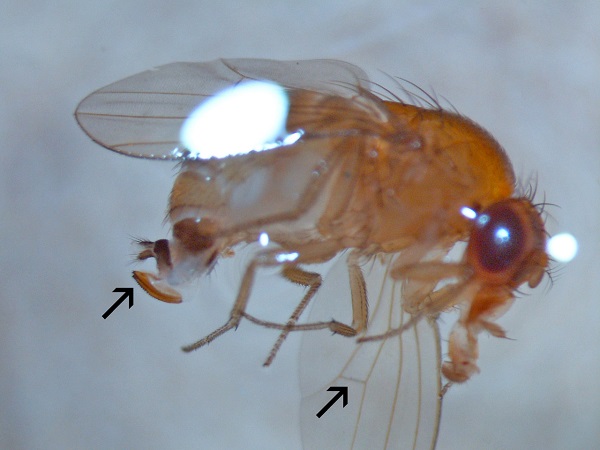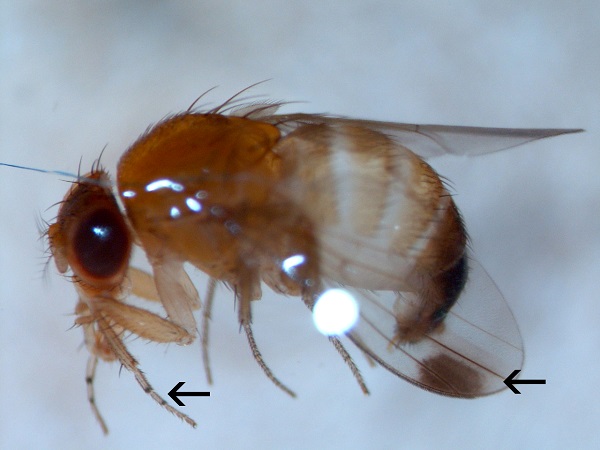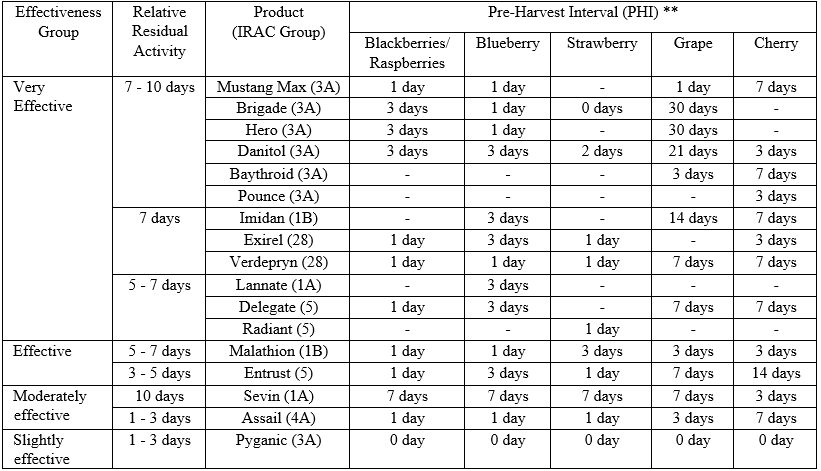Spotted Wing Drosophila Management
ENTFACT-230: Spotted Wing Drosophila Management | Download PDF
by Jessica Bessin and Ric Bessin
University of Kentucky College of Agriculture
First reported in Kentucky in 2012, we found spotted wing Drosophila (SWD) to be widespread in the state by midsummer of 2013. This new invasive pest lays its eggs in the flesh of many types of soft skinned fruits, most commonly in small fruits and berries. Attack begins during the harvest period resulting in collapse of the fruit after harvest and small larvae in the fruit.
SWD is a serious threat to small fruit production, the adults lay eggs under the skin of otherwise sound fruit. This can result in small larvae in the fruit at harvest or just after harvest. In addition to damaging a large percentage of a crop, this pest also has the potential to upset customers and ruin markets. Blueberries, blackberries and raspberries are very susceptible to this new invasive pest. However, in the SE US, June-bearing strawberries have not experienced these large losses and have lower risk to SWD than other later-ripening small fruit crops.

Figure 1. A SWD female with the arrow pointing to its modified ovipositor and wing cross vein.
Trapping in 2013 in commercial plantings detected SWD in 20 counties in all regions of the state. While these traps detected flies before fruit infestations were observed, in other states traps have not been consistent in their ability to detect adult SWD activity prior to fruit infestations being detected. In many states, commercial growers have had much more consistent results using host susceptibility (fruit beginning to soften and turn color) to time SWD sprays for highly susceptible small fruit crops destined for fresh market rather than using trap catch results to initiate sprays.
Producers wanting to use traps should read ENTFACT229, Spotted Wing Drosophila Biology, Identification, and Monitoring, for a description of the traps and their use. While we encourage growers to use traps, spray timing should be based on fruit susceptibility with highly susceptible mid-summer and fall crops. Traps can be made with materials commonly found at home.

Figure 2. A male SWD showing the wing spot and front legs 'banding.'
In other states where SWD has become established, producers need to spray periodically during the harvest period to reduce losses. Because of this, producers need to coordinate their harvests and spray timing in order to comply with pre-harvest intervals (PHIs) and seasonal limits with the respective insecticides. As the small fruit crops are harvested several times a week, harvest schedules limit the types of materials that can be used. Insecticide trials in OR, WA, CA, MI, NJ, NC, FL have identified a number of effective materials to protect small fruit crops from SWD. Some insecticides in the organophosphate, pyrethroid, spinosyn, diamide, and carbamate classes have demonstrated good activity against SWD. The neonicotinoids have not been as effective as some other classes. Conventional and OMRI approved sprays are available. There are also a few materials in the registration pipeline that have been shown to be effective.
Cultural Controls
There are several cultural controls that may be helpful. The first is frequent harvest and clean picking, also referred to as sanitation. This requires removal of overripe and damaged berries from the planting at least every other day. Raspberries that are picked a bit on the pink side will continue to ripen. Pickers can use two buckets, one for the marketable berries and the other for culls. Burial of infested fruit has not been effective as the SWD can still emerge. To destroy SWD in cull fruit, place fruit in clear bags and leave them in the sun. This should kill any SWD that emerge from the culls. Wine makers should manage pomace disposal to avoid issues with SWD and other fruit flies as well.
Post-Harvest Handling
Chilling of the fruit immediately after harvest is essential. Ideally fruit should be held just above their freezing point to not only arrest SWD development but to also kill many of the eggs and older larvae. However, even at 40F, SWD development is arrested and fruit quality preserved.
Wild Hosts
Removal of wild hosts (wild brambles, poke weed, mulberries, and honeysuckle for example) near commercial plantings may help but is not always practical or possible.
Insecticidal Control
While trapping can be used as a monitoring tool, commercial producers of highly susceptible small fruit crops should initiate SWD sprays when the fruit become susceptible. On these crops, the initial spray is applied a week before the expected first harvest. Sprays need to be in place prior to oviposition (egg laying), and coverage needs to be thorough as the adults often hide in the dense portions of the canopy. So, high pressure and spray volume will be needed to reach these difficult to reach spots and provide thorough coverage. Even the best of the insecticides will not consistently last more than 7 days so, at a minimum, weekly applications are needed. With heavy rains, sprays need to be reapplied.
Producers must rotate among insecticides with different modes of action (IRAC Group) to prevent/delay resistance. A general rule of thumb is to switch modes of action with each new pest generation, which would mean switching to a new IRAC insecticide group each week. Since this pest can complete a generation in less than two weeks, we need to switch modes of action weekly and have multiple types of insecticides available. With a limited number of modes of action available, we cannot afford to lose the effectiveness of materials to insecticide resistance.
Effectiveness of Small Fruit Insecticides for Spotted Wing Drosophila Management*

* Adapted from ‘Spotted Wing Dropsophila: A new Pest in Ohio’s Fruit Crops. C. Welty. 2013’
** ‘-‘ Not registered for use on this crop.
Revised: 8/22
CAUTION! Pesticide recommendations in this publication are registered for use in Kentucky, USA ONLY! The use of some products may not be legal in your state or country. Please check with your local county agent or regulatory official before using any pesticide mentioned in this publication.
Of course, ALWAYS READ AND FOLLOW LABEL DIRECTIONS FOR SAFE USE OF ANY PESTICIDE!
Images: University of Kentucky College of Agriculture
